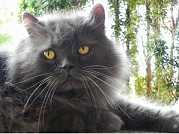|
The Feel-Good Guide to Sports, Travel, Shopping & Entertainment
|
||
| Main | Sports Events | Holidays & Observances | Pop Culture | Shopping | Travel |
|
MAIN
Its pedigree makes it one of the oldest breeds of cat known, with its modern claim to fame a distinctive short muzzle, round eyes, sweet and affectionate nature, and a long, luxurious thick coat.
Unlike the more rambunctious Maine Coon or the highly emotional Oriental cat, the Persian is one of the most docile pets and makes for an excellent lap cat and very affectionate friend. Quiet and undemanding, they are less apt to "talk" like the chatty Siamese cat, and their calm nature adapts to any family situation where they generally fit in well with other household pets.
Owing to their long coats, Persians require almost daily brushing and face washing, along with the occasional bath to keep their fur smooth and luxurious. The Persian's distaste for venturing outside is a blessing since, if allowed to roam free in the backyard, it may develop into a 24/7 grooming ordeal!
Those unwilling to make the commitment to keep their Persians well-groomed are often advised to select the Himalayan breed, a Persian and Siamese mix (in the UK known as the colourpoint Persian) whose coats are shorter and much easier to maintain. Generally fit and healthy, Persians are one of the top breeds prone to polycystic kidney disease. Due to their shortened muzzles, excessive tearing and nasal and respiratory problems are also an occasional concern.
• Persians first reached the height popularity in 19th century Britain, when Queen Victoria became very fond of the breed. Soon, English aristocrats and the upper classes all had to have one. • The classic blue-eyed white Persian is predisposed to deafness. The unusual "Odd-Eyed" white Persian cat -- which has one blue eye and one orange eye -- is only prone to deafness in the ear located on the same side as the blue eye. • The Persian isn't the best breed to have around rambunctious children. Mostly shy and reclusive, it is rather known for its impeccable manners. And a Persian will never shred up the curtains when left home alone! More information about Persian cats around the Web:
Caring for a Persian Cat - Check out a practical guide to their care and feeding, with special attention to maintaining their beautiful coat, with photos and related resources.
Exotic Shorthair | Maine Coon | Oriental | Ragdoll | Siamese | Sphynx
|
 A
highly-prized possession in the region of its origin, the Persian
cat arose in the area of what is now Iran and was, as the story
goes, first brought to the west in the 17th century by Italian
traveler
A
highly-prized possession in the region of its origin, the Persian
cat arose in the area of what is now Iran and was, as the story
goes, first brought to the west in the 17th century by Italian
traveler 

